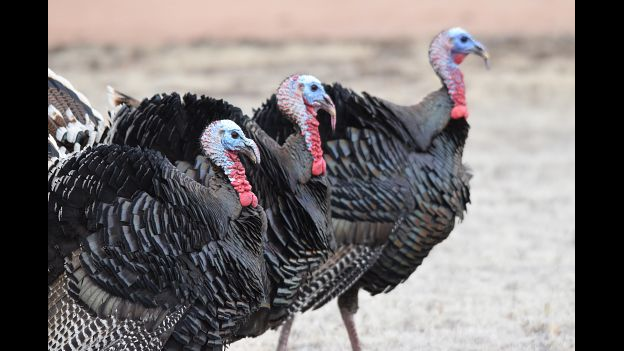Turkey
There are two species of wild turkey in Colorado: the native Merriam's and the introduced Rio Grande. Both offer fantastic wildlife viewing and hunting opportunities.

About This Species
Colorado's two turkey species are the Merriam's turkey (Meleagris gallopavo merriami) and the Rio Grande turkey (Meleagris gallopavo intermedia). Young turkeys are called poults, adult males are called toms, and adult females hens.
Conservation
Bringing Turkey Back to Colorado
Turkey populations were once decimated due to poaching and habitat destruction. In fact, during the period of the Great Depression, only 30,000 of them existed on the continent! To bring turkey back to Colorado, Colorado Parks and Wildlife launched a reintroduction program.
1980s
Colorado Parks and Wildlife began an aggressive reintroduction project
35,000
is what the Colorado turkey population grew to be as a result of reintroduction efforts
The abundant birds are now found in the majority of Colorado counties. The reintroduction of wild turkeys in Colorado has proven so successful that CPW has increased hunting licenses to help manage turkey populations in areas where the birds have become overabundant.
More Information:
Physical Characteristics
Toms can be up to 4 feet tall and weigh more than 20 pounds. Hens are almost as tall as the toms, but weigh almost half as much.
Turkeys have a colorful flap of skin hanging from their head called the wattle. Toms also have a fleshy growth on their forehead and bill called a snood that turn bright shades of pink, red, white, and blue during the mating season.
Plumes of dark feathers that appear more hair-like are called beards and protrude from their chests. All toms have beards, as do around 10% of hens. Beards begin growing around five months old and continue to grow throughout their life. Older toms can have beards over nine inches in length.
Merriam's
Adult males have white feathers on the lower back and tail feather margins. Their feathers are almost black with blue, purple, and bronze reflections and rumps of buff or white. The males have black-tipped breast feathers and hens have buff-tipped breast feathers. Females also have a whiter appearance when their wings are folded.
Merriam's turkeys have short to moderate beard length.
Rio Grande
Hens and toms have similar colors, with hens being slightly duller. Feathers on the breast, sides, and flanks are tipped with a pinkish buff color.
Rio Grande turkeys have moderate beard length.
Range
Merriam's turkey is primarily found in high elevation foothills west of I-25. They may move to higher elevations in the summer and move up to 40 miles between summer and winter habitats.
Rio Grande turkey is primarily found on the eastern Colorado plains east of I-25.
Habitat
Merriam's turkey can be found in a variety of habitat including ponderosa pine, aspen, and Gambel's oak.
The Rio Grande turkey inhabits brush areas near streams and rivers and in pine and scrub oak forests. They can be found up to 6,000 feet in elevation and prefer more open habitat. They have distinct summer and winter ranges. They can form large flocks of several hundred birds during the winter.
While they are often seen on the ground, turkeys roost in trees.
Reproduction
Toms attract females by gobbling and strutting. Toms gather harems in early spring, with hens laying around 10 eggs which are incubated for 28 days. The peak hatching period is late May through early June. Young turkey are called poults; they can flay at 10 days and begin roosting in trees shortly thereafter.
Threats to Species
- Climate Change and Severe Weather
- Balancing Recreation and Natural Resources
- Natural Factors
- Energy Development and Land Use